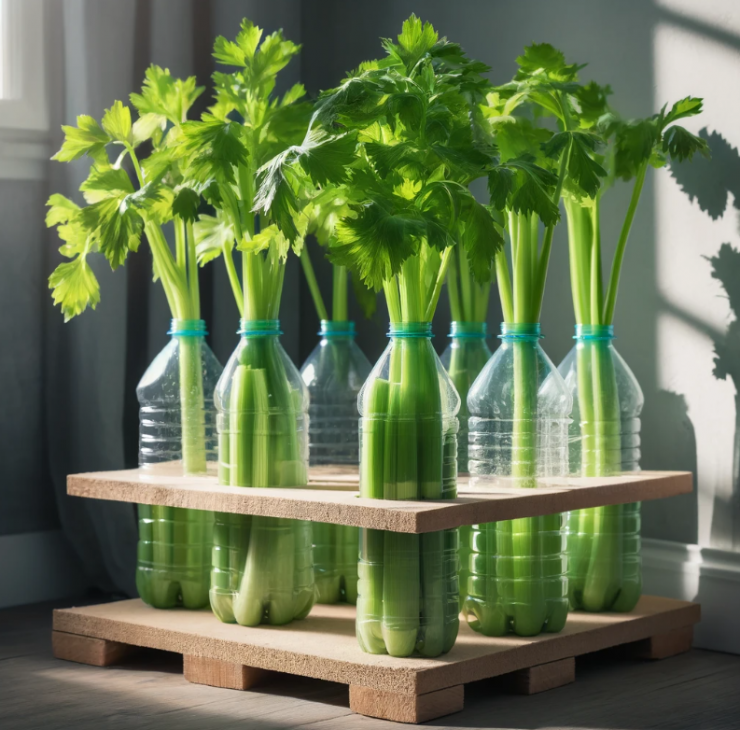Hydroponic gardening has gained popularity in recent years due to its efficiency, sustainability, and ability to produce high yields in small spaces. Celery, known for its crisp texture and distinct flavor, is a versatile vegetable that can be incorporated into a variety of dishes. However, traditional soil-based cultivation of celery can be labor-intensive and requires ample space. Enter hydroponic celery grown in recycled plastic bottles – a cost-effective and environmentally friendly solution that offers impressive yields.
The Hydroponic Advantage
Hydroponic gardening involves growing plants without soil, using nutrient-rich water solutions instead. This method offers several advantages over traditional soil-based cultivation, including:
Water Efficiency: Hydroponic systems use significantly less water than traditional soil-based methods, making them ideal for areas with water scarcity or drought conditions.
Space Saving: Hydroponic systems can be set up vertically or in compact spaces, maximizing yield per square foot.
Faster Growth: Plants grown hydroponically typically grow faster than those grown in soil, leading to quicker harvests and higher yields.
Controlled Environment: Hydroponic systems allow for precise control over environmental factors such as temperature, humidity, and nutrient levels, optimizing plant growth and health.
Recycling Plastic Bottles for Hydroponic Cultivation
Recycling plastic bottles for hydroponic gardening is a creative and sustainable way to repurpose household waste while growing fresh produce. Here’s how you can set up a hydroponic celery system using recycled plastic bottles:
Gather Materials: Collect clean, empty plastic bottles and prepare them for use by removing labels and rinsing thoroughly.
Construct the Hydroponic System: Cut the plastic bottles in half horizontally to create two separate pieces. The bottom half will serve as the container for growing celery, while the top half will function as a reservoir for nutrient solution.
Prepare Nutrient Solution: Mix a nutrient solution according to the specific requirements of celery plants. This solution should contain essential nutrients such as nitrogen, phosphorus, potassium, calcium, and magnesium.
Plant Celery Seedlings: Place celery seedlings or seeds into the bottom half of the plastic bottles filled with a growing medium such as perlite, coconut coir, or vermiculite.
Provide Nutrient Solution: Fill the top half of the plastic bottles with the nutrient solution, ensuring that the roots of the celery plants are submerged.
Maintain the System: Monitor the nutrient levels and pH of the solution regularly and top up as needed. Ensure adequate lighting, ventilation, and temperature control to support healthy plant growth.
Harvest Celery: As the celery plants grow, harvest stalks as needed by cutting them at the base. Celery grown hydroponically tends to have a crisp texture and intense flavor.
Benefits of Growing Hydroponic Celery in Recycled Plastic Bottles
Cost-Effective: Recycling plastic bottles for hydroponic cultivation reduces the need for expensive equipment and supplies, making it an affordable option for home gardeners.
Environmental Sustainability: By repurposing plastic bottles, this method helps reduce plastic waste and promotes environmental conservation.
High Yield: Hydroponic celery grown in recycled plastic bottles can produce impressive yields in a relatively short amount of time, providing a continuous supply of fresh, nutritious produce.
Space Efficiency: This method allows for vertical gardening, maximizing space utilization and enabling urban dwellers or those with limited outdoor space to grow their own celery.
Growing hydroponic celery in recycled plastic bottles offers an innovative and sustainable solution for producing fresh, high-quality produce at home. By harnessing the benefits of hydroponic gardening and repurposing household waste, individuals can enjoy the satisfaction of growing their own celery while minimizing their environmental footprint. Whether you’re a seasoned gardener or new to hydroponics, this cost-effective and efficient method is worth exploring for its potential to yield abundant harvests year-round.






Add comment